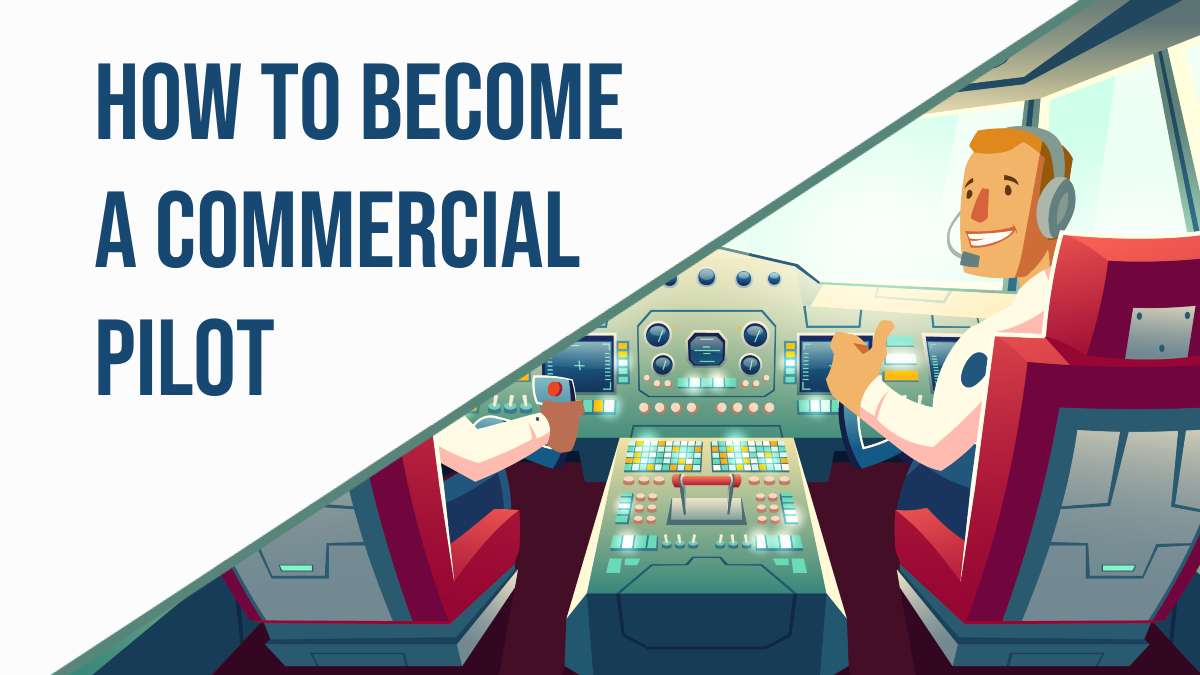
This article is for you if you’ve ever wondered how to become a commercial pilot. Although you may have considered it a pastime, becoming a commercial pilot is a fantastic career opportunity.
In reality, it can be helpful first to comprehend the precise characteristics of a commercial pilot.
A commercial pilot is, to put it simply, a pilot who has received Federal Aviation Administration approval to bill for their services. Therefore, what you may consider a pastime may one day lead to a job.
Also, you can able to know,
What Is A Commercial Pilot?
It is common practice for pilots to begin their careers flying for commercial airlines. At the very least, every pilot who flies for a living must obtain a commercial pilot’s license.
Commercial pilots are trained to operate aircraft for various purposes. It is including charter flights, search and rescue missions, aerial photography, and crop dusting.
What Does A Commercial Pilot Do?
Before we get into how to become a commercial pilot, let’s get an overview of what a commercial pilot does. The cockpit crew of most aircraft, except very tiny ones, consists of two pilots. In most cases, the pilot with the most flight hours, known as the captain, is in charge of the plane and is responsible for supervising the rest of the crew.
Flight responsibilities are split between the captain and the copilot, who is also sometimes referred to as the first officer.
These responsibilities include monitoring instruments, communications with air traffic controllers, and aircraft piloting.
Before takeoff, commercial pilots make a great effort to plan their trips, inspecting the aircraft’s many systems. And also, verify that the luggage and cargo have been loaded properly.
In addition, they discuss the flight path and weather conditions with the air traffic controllers in charge of monitoring the airport.
And also, the takeoff and the landing are the most challenging aspects of the flight. And, they need a high level of cooperation between the captain and the copilot.
Once the plane is airborne, it is common practice for the captain and the first officer. It is to take turns piloting each flight segment.
After touching down, pilots are responsible for filling out documents detailing their trip and the plane’s current state of repair.
The non-flight responsibilities of commercial pilots working for charter businesses are often far more extensive. They may schedule flights, maintain the aircraft, and balance baggage weight.
When piloting a helicopter, pilots have a continual responsibility to keep an eye out for potentially hazardous objects.
Warning sensors that detect rapid variations in wind patterns are something that all pilots, regardless of the kind of aircraft they fly, are required to keep an eye on. Because warning signs might occur at any time and without prior warning. Pilots must be ready to react rapidly to any potential threat.
They collaborate closely with both the flight dispatchers and the air traffic controllers. As a consequence of this, they need to be capable of coordinating their activities following the input that they get.
Steps on How to Become a Commercial Pilot
Almost anybody can learn to fly a plane and operate different aircraft types with the right instruction. However, to become a commercial pilot, one must complete a series of predetermined tasks.
Enroll with a private commercial pilot certificate
Obtaining a certificate as a private pilot is the first requirement to fulfill on the path to becoming a commercial pilot.
Pilot certification training and preparation includes learning flying principles and establishing the framework for advanced aircraft operation.
Most pilots begin training in simpler, single-engine rating aircraft and eventually go on to more advanced, multi-engine planes. On average, private pilot certification requires 40 hours of flight instruction.
Obtain a rating for your instrument.
Obtaining an instrument rating is the next procedure in realizing your dream of becoming a commercial pilot.
An instrument rating is a collection of credentials that a pilot has to have to be authorized to fly an aircraft while adhering to the requirements of the Instrument Flight Rules.
Obtaining certification for flying in instrument conditions enables pilots to be qualified to fly in any weather.
To get an instrumental-type rating, one must complete training and receive instruction in meteorology and instrument flying.
License for commercial pilot
Getting a license to fly commercial aircraft is the next thing to do. To receive a license, applicants need to demonstrate that they satisfy all of the standards. It is for commercial airline pilots and log at least ten hours of flight time in a high-quality aircraft.
100 of those hours must be as pilot-in-command, and 50 must be cross-country. The cost of acquiring a license to fly commercial aircraft is around $20,000. Pilots are legally allowed to accept payment for their services after they have obtained a pilot’s license.
Secure a flying instructor certificate
In some circumstances, commercial pilots will be required to get a certificate to teach others how to fly. This opens up extra work prospects for pilots and qualifies them for certain professions.
Here you can also enroll with Airline Transport Pilot (ATP) Certification for further qualification.
Get experience
Experience in the cockpit is often required for careers in the commercial aviation engineering industry.
For example, having a minimum of 1,500 hours of flying experience is one of the prerequisites for acquiring an Airline Transport Pilot license.
Perform your duties as a commercial pilot.
You may become a commercial airline pilot if you have all the requisite certifications and fly enough hours.
If you have professional pilots experience working for an airline, you have a great chance. So, you may also be qualified to apply for most local and international commercial pilot opportunities.
Read more: How to become a counselor without a degree
How Much Does It Cost? You Know How Long It Takes.
The course can be completed quickly, but can you afford it? The typical student finishes the training in about one year at roughly $70,000, which takes up their whole time. This assumes that you have absolutely no prior experience.
Time affects pricing. You will begin by earning your Private Pilot License and then get your Commercial Pilot License. After there, it is entirely up to you to decide how far you want to take it with it.
As a commercial pilot, it is worth getting insurance as well, but you should also try to stay away from insurance scams.
Most pilots get experience by working as flight training instructors or flying freight. Wow, that’s a steal! The more hours you are in, the more money you create flying!
After accumulating 1,500 flight hours in the United States, pilots can work for a passenger-carrying commercial airline.
In some other nations, such as Colombia, the minimum number of hours that must be worked is merely 250.
The entire cost of training depends on the pupils’ performance in their respective classes. In one year, most students may move from having no prior expertise to obtaining a CPL along with teacher ratings.
The cost may also change depending on several other criteria. So, the most important of which is the amount of time it takes you to complete it.
However, the expense is around $70,000 every year on average. Considering that the average annual salary for an airline pilot is more than $140,000 makes for a wise investment in your future.
Top Skills To Become A Commercial Pilot
To have a career as a competent pilot, you need to possess a variety of talents.
There is more to it than just mathematics and technical details. You must be inventive, work under pressure, and have a responsible attitude for this profession.
In addition to having good leadership skills, pilots must communicate well and contribute effectively to a group effort.
Proper communication
Although communicating well is beneficial in nearly every career, pilots are especially important.
Improper or insufficient communication between pilots and air traffic controllers contributes to around Eighty percent of all aviation mishaps and accidents.
If you are a qualified military pilot with these skills, you can also start your career as a commercial pilot.
For instance, charter and business flight pilots often warmly greet their passengers before takeoff. Even some airline pilots participate in the resolution of client concerns.
Clear awareness
Awareness means being aware of everything going on while flying, controlling, and taking care of an airplane.
Pilots must be able to picture where their plane is, its flight conditions, how it is set up, how much energy it has, and anything else that could impact its safety.
Team working
Individual crew members rather than a team typically linked to aviation catastrophes, according to research.
As a pilot, you must be able to function as part of a cohesive unit. Pilots must constantly cooperate closely with other pilots, air traffic controllers, and flight dispatchers on the flight deck.
They must be capable of coordinating efforts and providing candid feedback.
No shame should be attached to spotting and reporting an anomaly to a higher authority. Communication and cross-checking of each other’s work within the team have always benefited flight safety.
This is largely responsible for the aviation industry’s status as one of the safest high-risk businesses.
Thinking skills
The lack of time and resources and additional elements that increase pressure. They are turbulence, may make it difficult for pilots to make decisions. Pilots use checklists if they are confronted with challenges or crises.
These checklists include the particular steps that need to be taken to resolve the issue.
It does not cover every possible scenario. Even though they are aware that making a mistake in their judgment might result in the loss of their lives, pilots are required to have a level head at all times.
They are required not just to decide things correctly but also to do so in a very short amount of time. Most of the time, there is not one clear-cut choice that should be made.
The pilot is responsible for using good judgment to arrive at the most appropriate choice given the situation’s specifics.
FAQ
Should I complete my undergraduate studies before beginning my pilot training?
A bachelor’s degree is not essential to working as a commercial pilot. However, in addition to the real flying experience, several airlines may also demand that candidates have a bachelor’s degree.
In any event, earning a bachelor’s degree will increase your employment options in the aviation sector.
What academic fields should I focus on if I want to fly?
Unlike medicine or the sciences, no academic courses are offered at colleges that are expressly geared for flying airplanes.
However, prospective commercial pilots may find it useful to have a strong foundation in science and maths.
Studying geography and a foreign language may also improve your work prospects.
When applying for pilot jobs as a commercial pilot, knowing these topics might offer you an edge over competitors.
Is becoming a commercial pilot difficult?
Commercial pilots must possess a high level of technical expertise. According to many seasoned pilots, being in charge of the aircraft, crew, and passengers is the most difficult aspect of the job outlook.
A commercial airline pilot must complete extensive coursework, training programs, and flying hours before becoming certified.
Becoming a commercial pilot demands a lot of commitment, hard work, and devotion.
Still, it may be a rewarding career option for anybody who likes to travel and appreciates a challenge.
Read more: How to become a social worker without qualifications
Conclusion
The work of a commercial pilot is strenuous and difficult. On the other hand, it also has the potential to be a highly rewarding career path.
There are several options for travel and personal satisfaction associated with employment, in addition to the possibility of earning a significant pilot salary.
Now you may have a clear idea of how to become a commercial pilot.
It is vital to remember that becoming a commercial pilot requires a significant amount of training in addition to practical experience.












